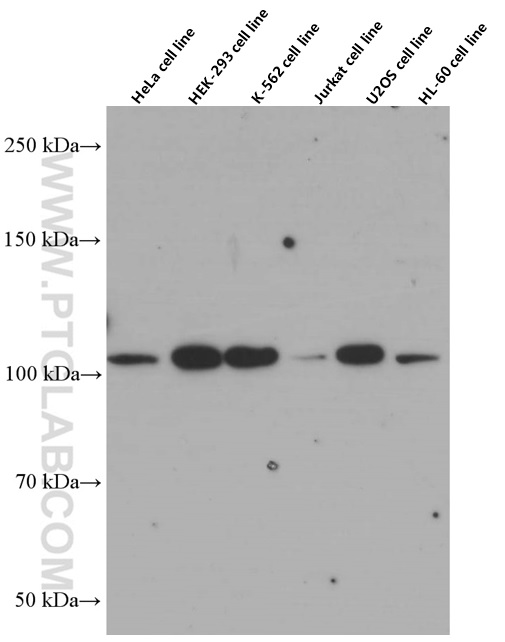验证数据展示
经过测试的应用
| Positive WB detected in | HeLa cells, HEK-293 cells, K-562 cells, Jurkat cells, U2OS cells, HL-60 cells |
推荐稀释比
| 应用 | 推荐稀释比 |
|---|---|
| Western Blot (WB) | WB : 1:1000-1:4000 |
| It is recommended that this reagent should be titrated in each testing system to obtain optimal results. | |
| Sample-dependent, Check data in validation data gallery. | |
发表文章中的应用
| IHC | See 1 publications below |
| IF | See 1 publications below |
产品信息
66448-1-Ig targets CP110 in WB, IF, IHC, ELISA applications and shows reactivity with human samples.
| 经测试应用 | WB, ELISA Application Description |
| 文献引用应用 | IF, IHC |
| 经测试反应性 | human |
| 文献引用反应性 | human, mouse |
| 免疫原 | CP110 fusion protein Ag3489 种属同源性预测 |
| 宿主/亚型 | Mouse / IgG2a |
| 抗体类别 | Monoclonal |
| 产品类型 | Antibody |
| 全称 | CP110 protein |
| 别名 | Centrosomal protein of 110 kDa, CP110, CP110 protein, KIAA0419 |
| 计算分子量 | 991 aa, 111 kDa |
| 观测分子量 | 110 kDa |
| GenBank蛋白编号 | BC036654 |
| 基因名称 | CP110 |
| Gene ID (NCBI) | 9738 |
| RRID | AB_2881817 |
| 偶联类型 | Unconjugated |
| 形式 | Liquid |
| 纯化方式 | Protein A purification |
| UNIPROT ID | O43303 |
| 储存缓冲液 | PBS with 0.02% sodium azide and 50% glycerol pH 7.3. |
| 储存条件 | Store at -20°C. Stable for one year after shipment. Aliquoting is unnecessary for -20oC storage. |
背景介绍
CP110, also named as CCP110 and KIAA0419, is an 110kDa protein. This gene is different to the gene CEP110 (geneID:11064; CNTRL). CP110 is a centriolar protein that positively regulates centrioleduplication while restricting centriole elongation and ciliogenesis. And it acts as a key negative regulator of ciliogenesis in collaboration with CEP97 by capping the mother centriole thereby preventing cilia formation.
实验方案
| Product Specific Protocols | |
|---|---|
| WB protocol for CP110 antibody 66448-1-Ig | Download protocol |
| Standard Protocols | |
|---|---|
| Click here to view our Standard Protocols |
发表文章
| Species | Application | Title |
|---|---|---|
Mol Biol Cell The ARF GAPs ELMOD1 and ELMOD3 act at the Golgi and cilia to regulate ciliogenesis and ciliary protein traffic. | ||
Mol Biol Cell Phylogenetic profiling and cellular analyses of ARL16 reveal roles in traffic of IFT140 and INPP5E |
